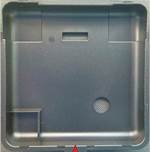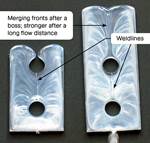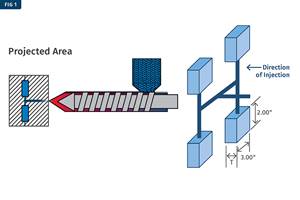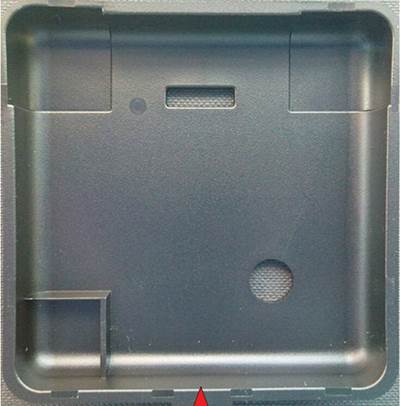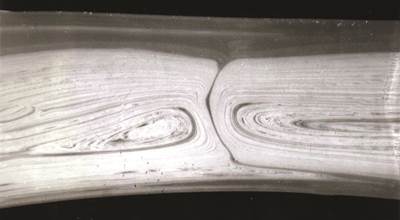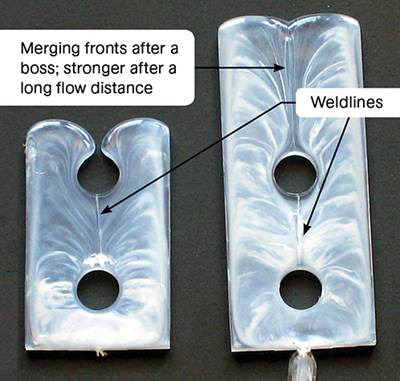The Difference Between Knit and Meld Lines--and Why It Matters
In many part designs, flow fronts will inevitably be split, but how and where they come back together is hugely important to the molded part’s finished strength.
Three terms that often get mixed up in injection molding are weld, meld and knit lines. Meld and knit lines are actually both different types of weld lines. Let’s review what causes meld and knit line imperfections, how they’re different, and how they affect part durability.
What Causes Knit and Meld Lines?
Like many part inconsistencies, these unwanted features are rooted in product design. Since material is injected through a gate, it must flow through the cavity and around various features, such as holes or bosses.
Think of it like water flowing down a river with a rock protruding through the surface. Once the water hits the rock, the flow must split, continue around and converge on the opposite side. You want to focus on is that converging of resin to determine if it’s creating a knit or meld line.
Why does this matter? If a knit line is present in a screw boss, the boss will likely crack when a screw is driven into it, leading to part inconsistencies. For automotive parts, this results in parts that bump, squeak or rattle. For electronics, the broken screw boss will not allow proper compression of a seal, causing a PCB (printed circuit board) to be susceptible to water damage, for example.
For plumbing parts, if these occur in an O-ring groove, there is a possibility that there will be a weeping of fluid causing a slow drip. In a pipe fitting, if these issues are not managed well, a fitting will not pass burst or crush testing, yielding product field failures.
Meld Lines
A meld line is defined as the re-merging of two flow fronts after the plastic flow has been split by a feature within the part design. One way to think of this is to visualize merging onto the freeway after a long day at the office—all the vehicles are going the same direction and have to figure out how to get there without damage. In the accompanying figure, we can see how the flow front splits due to the rectangular core-out and merges again on the opposite side. Since there is more space inside the mold cavity, the molten resin continues onward, creating a new flow front.
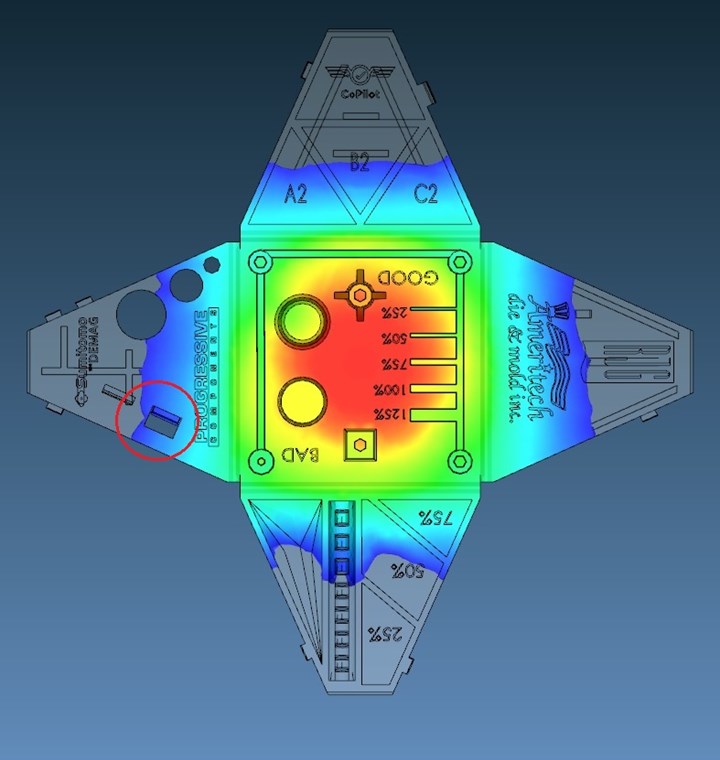
Material flowing around and converging after the rectangular core out, continuing to flow and forming a meld line.
This joint is not as strong as an uninterrupted flow. However, since the flow front can merge together and continue flowing through the cavity, there is a greater chance of being able to pressurize this area, therefore increasing its strength.
Knit Lines
A knit line is when two flow fronts come together but, rather than merging, it’s like a head-on collision at a four-way stop. This isn’t pretty and will not end well. Once these two flow fronts meet, there is no more cavity geometry to flow through, thus making it difficult to pressurize this area of the part, subsequently the result is even weaker than a meld line.
Material Selection Matters
Certain materials are more forgiving when it comes to weld lines due to their inherent strength. Resins like HDPE, PP and POM (acetal), which have a streamlined structure, typically yield higher strengths because the polymer chains can more easily intermingle. The random structures that contain benzene rings found in other materials like PC, PMMA and ABS reduce the ability for the polymer chains to easily merge together. These benzene rings also increase the viscosity, reduce shrink rate, and increase strength with the exception of knit and/or meld lines.
Materials that have physical fillers like glass, carbon, metal flakes, etc. reduce the ability to positively influence the strength of a knit or meld line. This occurs for several reasons. First, the temperatures in which we process most thermoplastics—400 to 600 F—are drastically below the melting point of those types of fillers; glass for example, has a melting point ranging from 2552 to 2912 F, if they melt at all. In this situation, not only do we have a feature inside the cavity impeding the plastics flow, but we have a solid suspended in the flow front, wreaking further havoc. Therefore, we need to review the fiber orientation prior to the feature and how it differs after the feature.
A Closer Look at Testing
The key to understanding changes in strength for a part that has been compromised is understanding how test samples are broken down and how the data are collected. The Izod impact test uses a weighted pendulum to strike a sample. Readouts are provided in the amount of energy required to break the sample, typically in ft-lb/in2. The more energy required to break the sample, the stronger the material is.
Another area to consider is the ASTM data from the notched and unnotched samples. Due to the elements that create the polymer, their arrangements and bonds determine how much strength is retained. A knit line is similar to a notch in the ASTM sample. Though a molded part with a knit line may not behave exactly like the test sample, the data sheet will show us how much strength could be potentially lost.

As an example, there are certain materials that are so strong that the ASTM test cannot break the unnotched sample, but the value of the notched sample is tremendously low. One example of this is PC used in the medical industry, shown in Table 1. Other materials, like PP shown in Table 2, are breakable in the ASTM test method when both notched and unnotched.
Neither of these materials are bad, but we must understand their limitations and how to properly accommodate the design to achieve the desired objective. The key to assessing a material’s strength is examining the drop-off between the unnotched and notched sample. This can help us understand how the strength of a knit line could potentially be compared with an uninterrupted flow of plastic.
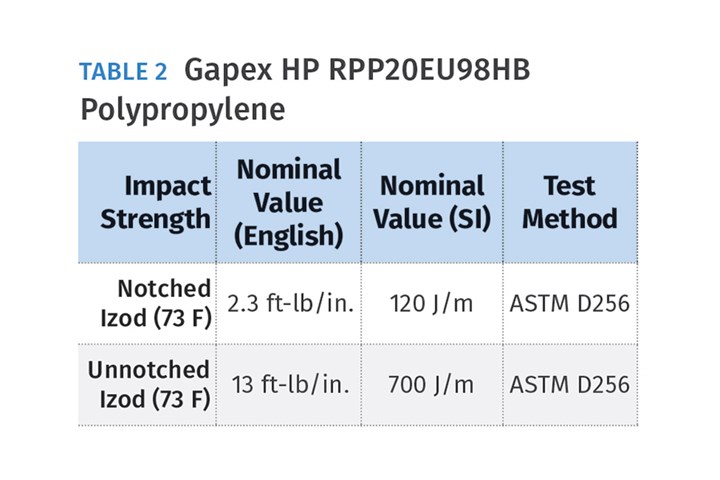
Mold Design & Processing
Where a knit or meld line is located within the part geometry is heavily influenced by the gate location. Through the use of flow simulations, we can predict where those may occur. However, gate locations may be selected based on part functionality, placing knit or meld lines in suitable areas for proper functionality.
Improving the strength of knit or meld lines with processing can be tremendously difficult, since there are so many factors that are already locked in, such as part geometry, gate location, flow length, and material. The best we can hope for is to pressurize the knit or meld line better through the combination of melt temperature, mold temperature, flow rate, and holding pressure.
The differences between knit and meld lines are significant, and they can dramatically impact the part’s structural integrity. Knit and meld lines are inherent to plastic injection molding. Eliminating them is often difficult due to product requirements. However, with a collaborative effort between product designer, mold maker and molder, success is certainly obtainable.
ABOUT THE AUTHOR: Jeremy Williams has more than 20 years of experience in the plastics industry serving the medical, automotive, furniture and appliance industries. He previously worked as a principal engineer, taking projects from design concept to salable products. Williams earned his Master Molder II certification in 2011; became an RJG Certified Trainer in 2012; and started at RJG in 2015. In addition to his manufacturing background, he holds degrees in plastics and business. Currently Williams is a Consultant/Trainer in RGJ’s TZERO program. Contact: 616-307-4953; tzerocore@rjginc.com; rgjinc.com.
Related Content
A Systematic Approach to Process Development
The path to a no-baby-sitting injection molding process is paved with data and can be found by following certain steps.
Read MoreBack to Basics on Mold Venting (Part 1)
Here’s what you need to know to improve the quality of your parts and to protect your molds.
Read MoreIs There a More Accurate Means to Calculate Tonnage?
Molders have long used the projected area of the parts and runner to guesstimate how much tonnage is required to mold a part without flash, but there’s a more precise methodology.
Read MoreKnow Your Options in Injection Machine Nozzles
Improvements in nozzle design in recent years overcome some of the limitations of previous filter, mixing, and shut-off nozzles.
Read MoreRead Next
More Gloss, Fewer Weld Lines With Variothermal Molding
A higher mold surface temperature during filling is required to achieve high-gloss surfaces or perfectly replicated microstructures and nanostructures, as well as erasing ugly weld lines. Instrumented tests quantify the results achieved by this process.
Read MoreWhat to Do About Weak Weld Lines
Weld or knit lines are perhaps the most common and difficult injection molding defect to eliminate.
Read MoreCoping with Weak Weld Lines
Weld lines cause significant reject rates and are a common problem that all molders face.
Read More
